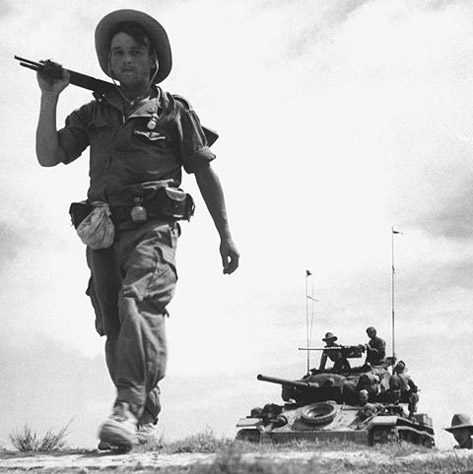France (location: Indochina) 1950-54

French Foreign Legion patrol in the Red River delta
After the Japanese were defeated in World War II, the French attempted to reestablish their control over Indochina. They quickly found themselves confronted by an uprising led by the Viet Minh. Although a strong current of opinion in the U.S. detested French colonialism in the area, Roosevelt saying acerbically that “France has had the country – thirty million inhabitants for nearly one hundred years, and the people are worse off than they were at the beginning,” the U.S. never seriously challenged French rule and rapidly saw the Viet Minh as a foe to be overcome. This policy stemmed in part from France 's status as a U.S. client with a powerful Communist party seen by Washington as poised to take over in the case of a government crisis, and in part from the fact that U.S. officials were fixated on the Viet Minh's communist affiliations.
In early 1950, when France had granted the Associated States of Indochina a mostly fictitious independence, the U.S. granted diplomatic recognition to those states and quickly began sending military aid to Indochina, or, to be more specific, to the French in Indochina; all U.S. aid, from beginning to end, went only to the French, who used it as they saw fit. This was made possible by the Mutual Defense Assistance Act passed toward the end of 1949, which permitted the president to spend up to $75 million in military aid in “the general area of China .” Shortly thereafter, the U.S. announced that it was going to increase its military aid and in September, a MAAG for Indochina was set up. The outbreak of the Korean War had led Truman to accelerate the delivery of aid, with the result that large quantities of weapons and equipment began sluicing into French hands: during “a single week [in] January 1951 the French received from the United States 20 M24 tanks, 40 105-mm. howitzers, and 250 conventional bombs, as well as napalm bombs, 105-mm. ammunition, automatic weapons, and small arms.” Aid began to be sent straight from U.S. stocks in Japan . By January 1953, 900 combat vehicles had been delivered to the French, along with “15,000 other vehicles, almost 2,500 artillery pieces, 24,000 automatic weapons, 75,000 small arms, and nearly 9,000 radios. In addition, French air units had received 160 F-6F and F-8F fighter aircraft, 41 B-26 light bombers, and 28 C-47 transports plus 155 aircraft engines and 93,000 bombs.” By the time of the final French defeat, U.S. aid was running at over $1 billion a year (about $5.8 billion in 2004 dollars) and paying some 78% of the French war costs.
The U.S. effort in Indochina was a combination of large-scale weapons shipments and a largely hands-off role as regards advising and training, ruled out because of French sensitivities. In one sense, there was nothing intermediary about U.S. actions: France was a U.S. client and the U.S. was supplying it with weapons. In another sense, though, France was a third party, because the U.S. concern was not only to prop up the regime in Paris but to make sure that the Associated States did not come under communist rule. That goal was to be achieved, ideally, by Vietnam , Laos , and Cambodia gaining complete independence but remaining as French clients. In fact, even if the French had acceded to repeated U.S. pleas to permit direct training of Indochinese troops, this still would not have substituted the U.S. as a patron for France , since the French would still have had ultimate responsibility for maintaining the regime. In the end, U.S. policy in Indochina was not all that different from its policy in Greece . In that latter country, as we discuss elsewhere on this website, the British were too short of money and manpower for the U.S. to stay out entirely or simply to furnish weapons as it did in Indochina; but if the French had not been so touchy about their role, the U.S. might well have ended up, as in Greece, training troops directly. We can also imagine that if the situation in Jordan had worsened in 1958 (see the discussion in chapter three of the book), the U.S. would have played a similar role there as regards the U.K.; similarly, if things had not gone well, U.S. aid to France for Chad in the 1980s (again, see chapter three) could easily have transformed into an Indochina-like policy. In short, the emergency aid to the French in Indochina is not so much a unique case of U.S. military intervention on behalf of a colonial regime as a slightly more extreme case of intervention via intermediaries. 1
1) Pentagon Papers (1971: vol. 1: 11, 77); Spector (1985: 137, 168); Gibbons (1986: ch. 2).
